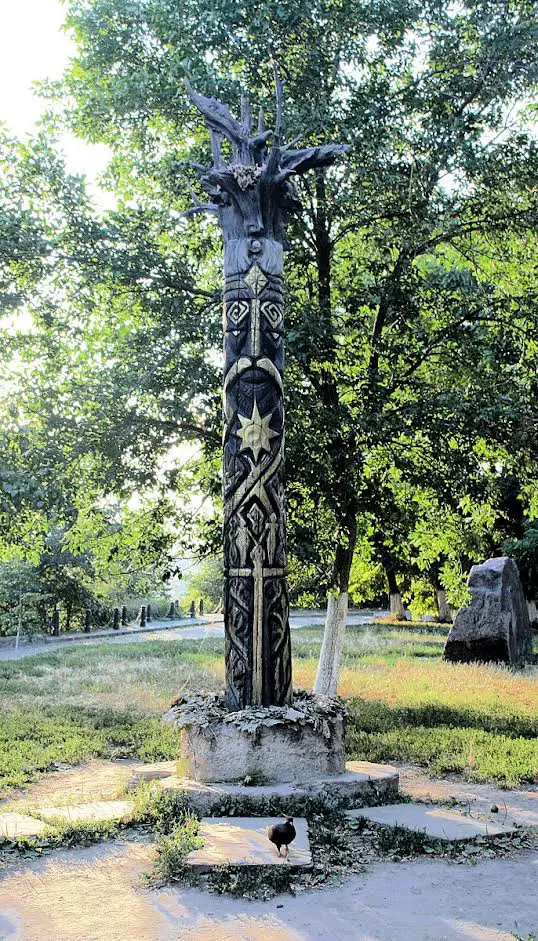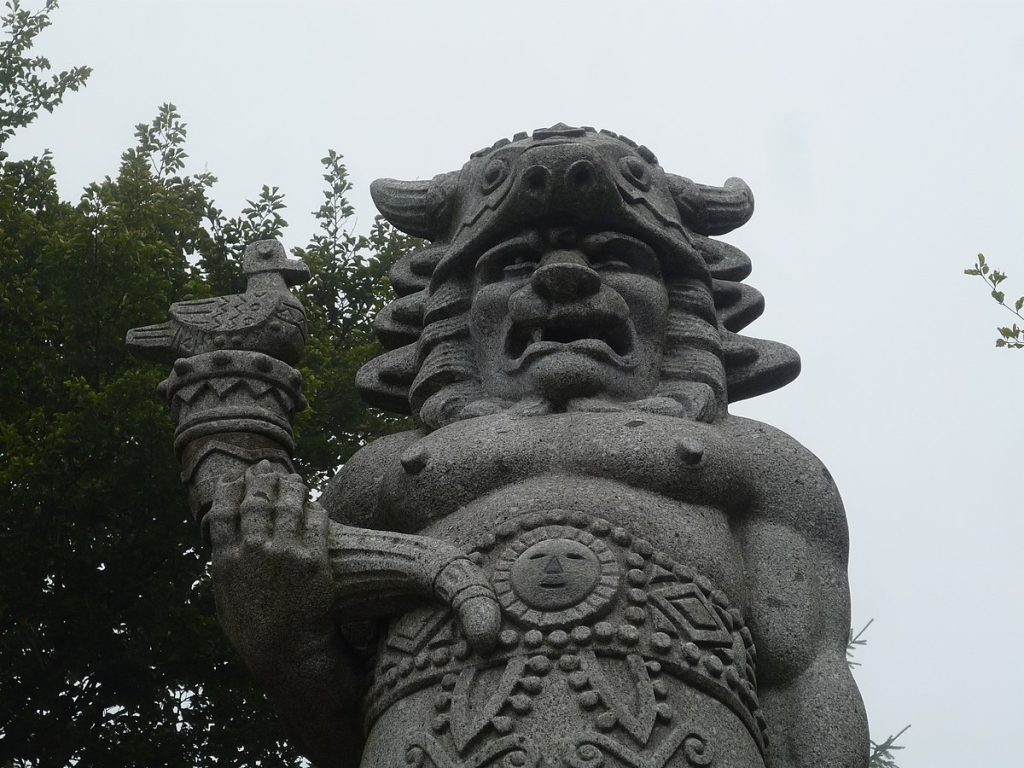Just as it happened in other corners of the world where people of Egypt, Sumer or even Nordic people created their own system of beliefs and shaped them into a universal cosmogony and theogony, thus trying to give an explanation to the world and life that was, in those early stages of human development, just revealing to them, old Slavic tribes followed in those same footsteps and provided a unique explication to the fundamental existential questions consequently creating a system of their own device. Though unparalleled in a way, the Slavic set of beliefs bears a close resemblance to all other mythologies of the ancient world, only to prove that these cultures influenced one another and that the same questions astounded them, and the desire to unravel these from the realm of the unknown is something they all had in common.
Slavs shaped their spiritual life around an animistic-polytheistic system of beliefs with personified forces of nature and integrated ancestral cult (Vukdelić 2021, 333). Religious beliefs of the old Slavs were deeply rooted in their common ancestral origin and even further more in the past in their common proto-Indo-European origin (Vukdelić 2021, 334). A close resemblance between swastika and kolovrat – a symbol closely associated with Svarog, the supreme deity in Slavic religion, symbolising a never-ending cycle of birth and dying – proves the connection and possibly direct influence of the proto-Indo-European cults on Slavic religion. Both symbols, in their spinning form, also represent the Sun.
Though the beliefs of old Slavic people could be colloquially understood as dualistic, strictly speaking, they were not. The dualistic concept implies that gods were strictly divided into good and bad, but with Slavs things are somewhat different. All deities in the pantheon could have both good and bad attributes and powers that they could resort to and exert onto the people that were subjected to them. This conception comes from their understanding of forces of nature and close association and personification of those forces with the gods they were worshipping.
SVAROG
Svarog was the supreme deity in some tribes of the ancient Slavic people. He was known as the deity of the sky and the Sun. Its cult was worshipped in the ancestral land of the Slavs, and it is considered that it originated from the old Hindu deities Svarga or Varuna, since the cult of the Sun was widely spread with the people in the East (Ledić 1969, 27).
Though in most Slavic tribes, Svarog was the supreme deity, the creator of Heaven and Earth, in some tribes in his place stood Perun, a deity that shared similar attributes, and was placed on top of the pantheon.
In their imagination Svarog was the most powerful deity and a forefather of all other gods (Ledić 1969, 29). In his honour sanctuaries were built and statues erected where sacrifices were offered to him. Other notable attributes of this supreme deity were that he was god of the blacksmith craft, and his offspring were worshipped as sun gods and flame and single deities (Ledić 1969, 28). He was considered to have supreme judicial authority. He had the power to distinguish right from wrong, and accordingly, in the footholds of his statues that stood in the sanctuaries made in his honour old Slavs held their court trials and made verdicts of justice invoking his name (Ledić 1969, 37).
Subsequently, myths were derived from the supreme deity and transferred to his offspring – minor deities. Svantevid was another personification of the Sun; Perun – God of thunder and lightning; Daždbog, also known as Perun in some tribes – God of rain; Zora – Goddess of dawn; Danica that represented Venus; and God of the young Sun – Svarožić (Ledić 1969, 37).
According to their beliefs, Svarog personified the sky and gave birth to two children – sun and fire. The Sun was considered to live in the east, where from a golden palace, it emerged every morning in its carriage pulled by white fire-breathing horses (Ledić 1969, 37).
PERUN

(Photo credit –Ukrainian ridnovir)
The myth of the thunder god dates deep into the history of the Slavic tribes. Ancestors believed that Perun abides high in the clouds from where he rules and governs life on Earth (Ledić 1969, 49).
He was credited with presenting fire and light to the people, and was anthropomorphised as a man holding a hammer or a bundle of lightning bolts in his hand. According to the lore, he presented the gift of fire to the people by setting chunks of tinder on fire and sending them to Earth (Ledić 1969, 49).
As a very important deity, second only to Svarog, he had many powers that were attributed to him, all of which people considered important in their life that was so strongly intertwined with nature. They believed that by controlling thunder and lightning, he was sending rain, vital for successful harvesting and the prosperity of the tribes (Ledić 1969, 50).
Protecting people from forces of dark and evil was also something that he was credited with, just as he was the protector of fishermen and tamer of sea storms, but he was also a patron of homes. His name was invoked upon building new houses. To point out how important this deity was, the fourth day in the week was named after him – “Perenden” – just as Germanic and Nordic tribes did to honour their counterparts Donner and Thor (Ledić 1969, 50).
As a lover of peace and justice, Perun was portrayed as a deity that felt joy when seeing fields that abound in golden grain and fruitful harvests, and was invoked by the ancestors when negotiation took place between warring tribes and peace deals were brokered (Ledić 1969, 52).
Many important landmarks and sites were named after him, like hilltops, mountains and cities. Some tribes, notably those abiding in the region of southern and western Balkan, ranked him as the supreme deity surpassing even Svarog. It is important to emphasize that there is no fixed pantheon of Slavic deities, and that beliefs differ from one tribe to another just as the attributes of gods often time overlap.
VOLOS
Another notable deity in the spiritual life of old Slavs was Volos, deity of shepherds, herds and rearers. Slavs, as an agricultural and stock-herding people, embraced the cult of worshipping Volos. They considered him to be the deity of farmers and fertility and a protector of shepherds. Evidence of the importance of Volos to the people was a shrine that stood in Kyiv, and was known as Kyiv Pantheon (Ledić 1969, 74). A shrine in which together with the statues of other Slavic gods a statue in Volos’ honour was erected. As it often times was in other cases, he also shared his attributes with other gods. His powers overlapped with those of Perun since he was believed to be the avenger of the broken pledge between the tribes, and also vows for peace were taken invoking Perun and Volos.
He was anthropomorphised in many ways, differing from one tribe to another. In the tales of the old, he was depicted as a blind old man. In some places, he was imagined to have two eyes, while somewhere else he was thought to be a one-eyed giant holding a lamb while an ox lied next to his feet (Ledić 1969, 75).
Volos was worshipped in shrines, but also on the hills and in the mountains and groves (Ledić 1969, 77). Slavs named the constellation Pleiades in his name, and to them it was known as the constellation Vlašić, Vlastovice, Vlastari or Lastari depending on the tribe (Ledić 1969, 78).
When Slavs migrated from their ancestral lands, they would often times name certain places, settlements or hilltops in honour of their gods. As proof of this, we have the city of Volin on the confluence of river Odra in the Baltic; the river Volga’s name was derived from Volos, then there is Volosko in Kvarner, Veles in Macedonia, etc.
As Christianisation took place, gods of the old were starting to be abandoned and their influence on people’s spiritual life slowly decayed. Attributes of the old gods were blended with new Christian saints with the aim of gradually overtaking a pivotal role in their spiritual life and substituting old pagan religion with a new, proclaimed one. Volos was most likely substituted with St. Blaž or Vlaho who was attributed with being the protector of livestock (Ledić 1969, 80).
VODAN
In every corner of the world from ancient times, evidence can be found of worshiping the cult of water. Just as it is with the Sun, Moon and thunder – all natural phenomena that occupied the attention and imagination of our ancestors – water, in its own right, holds a position very high in the pantheon of old pagan religions.
Every major river had its deity that, by belief, abided in it. Well-known are ancient gods of the sea – Poseidon and Triton in Greece; Neptune was admired in ancient Rome; the God of the river Nile was worshipped and even Ganges, Jumana and Sarasvati had its feminine deities; and to parallel them Savus, Dravus and Drinus were the deities that bore the name by the matching rivers (Ledić 1969, 87).
Old Slavs worshipped Vodan – the deity of seas and rivers. Vodin, Vodjan and Voden were all alternative names of the same deity that spanned throughout Slav territories. Vodan was worshipped as a protector of seamanship and the shipping trade. He was depicted as a long-haired bearded man holding a trident, just as his counterparts in Greece and Rome. Sacrifices were offered to him after a successful fishing venture and prayers said before indulging in seafaring or fishing trips. Slavs also believed that nymphs and fairies abided in waters, and just as it is in other religions, they were depicted as beautiful and helping maidens, but treacherous if insulted or hurt – all features that can be paralleled with characteristics of the sea (Ledić 1969, 89).
Vodan was the supreme deity of waters, but had a great number of offspring that were all deities of particular springs or rivers. They were known as Rusalke in the ancestral land of the Slavs, or simply fairies in their new homelands such as it is with Polish, Czech or Croat people, and were traditionally depicted as beautiful maidens with long unraveled hair who were on good terms with the people (Ledić 1969, 90). Fire and water were the main agents for spiritual purification. The effect was accomplished by ritual baths in rivers or by jumping over burning bonfires, a rite that found its way into tradition of the native people and was kept as a custom in some places till modern times. An interesting rite was held during late spring nights on the river banks when young men and maidens would rush to the rivers while fires were lit on hilltops and along the lowlands of the Dniester an Vizsla rivers. This custom served as a way for young women to meet their future life companions. This was known as “Meetings of the Rusalke” (Ledić 1969, 92).
In their ancestral lands, Slavs buried their dead near river banks and those places were regarded sacred. Such was the importance of water to them. This custom kept even in their new homeland. Numerous sites of burial places and necropolises along Sava, Drava, and Danube rivers bear witness to the continuity of this practice (Ledić 1969, 91).
SVAROŽIĆ
This deity is derived from the name of Svarog. He represents a young sun god. Originated with the tribe Veneta that abided in the Baltic, but was also worshipped in Russia as a god of the young sun and giver of gentle warmth and light (Ledić 1969, 108). According to their beliefs, he was born every year around Christmas time, symbolising a weakened sun that is about to rejuvenate and renew his strength. Metamorphosis of this deity are seen in other tribes in the form of Jutrobog, when the sun strengthens; or Daždbog in Croats, when rain falls as a blessing on the fields and crops; and in the summer, he is Vid or Svantevid, a god of harvest on the island Rugen in the Baltic sea, and when the crops are ready for harvesting he is Trebun in western and eastern Slavs (Ledić 1969, 108).
The deities mentioned above are the ones that were the most important and were worshipped the most in the mythical-religious life of the old Slavs, but the full scope of it poses a formidable challenge to envelop in a single paper. That being said, I would just like to mention a few others along with displaying what they were attributed with.
Radogost was a protector of hospitality, an attribute that is well-known to the Slavic people. Vida was a protector of marital harmony. She was the marital companion of Svarog. Slavic women prayed upon her for help and happiness in love and marriage. Vesna symbolised joyful spring and lushness, a cult similar to Germanic Ostari and Egyptian Osiris. Lada, a goddess of love, hot summer and harvest, was credited with being the commander of all fruitful urges in nature (Ledić 1969, 129-165).
As Christianity emerged as a new and prosperous religion that was about to suppress religions of the old, and Christianisation took place even as early as in the 3rd or 4th century, and the world was on a brink of a radical change as the might of the Roman empire was coming to an end, the spiritual life of the Slavic tribes was not left aside and bypassed by those changes, but was fully included in reshaping the future of the religious life in Europe.
During the process of Christianisation and after its so-called completion, Slavic people kept their old traditional magical-religious beliefs and practices parallel with their new religion. In essence, this was a tacit agreement between the Christian clergy and the people. A political concession was made by the clergy so as to avoid massive rejection of the new faith among the domicile inhabitants. The substitution of mythological gods with Christian saints that took over their attributes is in keeping with the agenda of slowly entering and consequently dominating the spiritual domain in their lives.
These two essentially different systems of beliefs in practical life and in spiritual rituals often collided with each other, but the contradiction between the two, nevertheless, posed no problem for the people to develop a certain syncretistic attempt to merge the two (Vukdelić 2021, 345). Such contradiction can be seen in perception of time. Slavs conceived time in myths as a cyclic image of ever-renewing in which forces of nature always restore its balance, contrary to Christianity with its linear perception of time and a world that has its beginning and moves towards its end (Vukdelić 2021, 342).
This attempt of syncretism proves not only that the process of human theological, cosmogonical and philosophical development has not yet come to an end but also, that, most likely it never will. Due to the nature of the subject matter, humanity will undoubtedly witness yet another series of both intentional or political-so to speak, and unintentional interferences into the corpus of the spiritual life and practices as a whole in the coming future.









